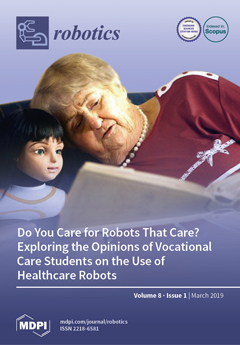Robotics, Volume 8, Issue 1 (March 2019) – 23 articles
There is a rapid increase in the population of senior citizens in many countries, and the shortage of caregivers is therefore becoming a pressing concern. Healthcare robots are being deployed in an attempt to fill this gap and reduce the workload of caregivers, but introducing robots in the field of care has raised a lot of concerns. Can we give Grandma a robot to keep her company when she is lonely? Is providing an elderly citizen with robot technology considered as ‘good care’? These are not questions of occupational ethics and utility for caregivers or end-users alone: It is important to study the attitudes of trainee caregivers as well, as they may easily come across such new mechanical colleagues on the work floor in the near future. Giving voice to trainee caregivers to express their concerns will encourage better partnerships between human caretakers and upcoming artificial systems.
- Issues are regarded as officially published after their release is announced to the table of contents alert mailing list.
- You may sign up for e-mail alerts to receive table of contents of newly released issues.
- PDF is the official format for papers published in both, html and pdf forms. To view the papers in pdf format, click on the "PDF Full-text" link, and use the free Adobe Reader to open them.





